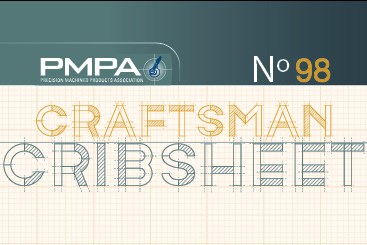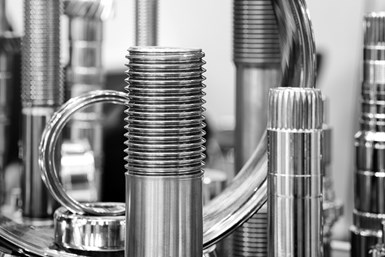Craftsman Cribsheet No. 98: Thread Milling
Contributed by Dave Sibinski and Roberts Automatic Products, Chanhassen, Minnesota.

This cribsheet explains some reasons why to consider thread milling using three-axis CNC vertical or horizontal machining center. The process uses helical interpolation, so the machining center controller must have the ability to control all three axes simultaneously.
Some Advantages
- The cutter runs at the optimum speed for the material.
- The spindle runs at a constant speed with no reversal necessary.
- The thread size can be adjusted in tenths by offsetting the path of the cutter.
- A thread can be produced to full depth ½ pitch from the bottom of a blind hole in production.
- The chips produced by the cutter are very small, easily washed away with coolant.
- The process is very fast, usually faster than tapping.
- The same cutter can be used to produce many different thread sizes. Example: 3/4"-16, 7/8"-16, 13/16"-16, 1"-16; with the same tool.
- A small machine can produce a very large thread. Example: 4"-16. This thread is too large to tap in most machining centers.
- The cutter can be made to control the major, pitch and minor diameters.
- The process works on internal or external threads.
- The thread start can be controlled.
- Cutters can be resharpened.
- A right- or left-hand thread can be done with the same cutter.
- Some threads can be run dry.

Two Primary Disadvantages are Costs and Maximum Depth on Internal Threads.
- Cutter cost can be an issue. The cost of the tool itself runs into the hundreds of dollars (It costs about $200 for a thread mill to produce a 3/8"-24 internal thread. A tapered thread mill to produce a 1/2"-14 NPTF thread costs about $390.)
- The maximum effective thread depth that can be milled can be an issue. The maximum practical depth is about 2 diameters, because the cutter geometry must be smaller than the minor diameter of the internal thread.
External threads can often be milled using an insert-type cutter. While the cutter body runs into the hundreds of dollars and inserts can be in the $40-50 range, in the long run the titanium nitride-coated carbide inserts cost less, while operating at faster speeds and longer tool life.
Related Content
-
What Does the Future Hold for Leaded Steels?
12L14 and other leaded steels are no longer melted in the U.S.
-
‘Can You Hold This Tolerance?’ Is Not An Engineering Question
The implications of tolerances go far beyond mere technical compliance.
-
Process Parsimony — Automation’s Secret Key for Scale and Quality
Automation is thought to be the secret to improving quality in manufacturing. What if I told you it was something else?




